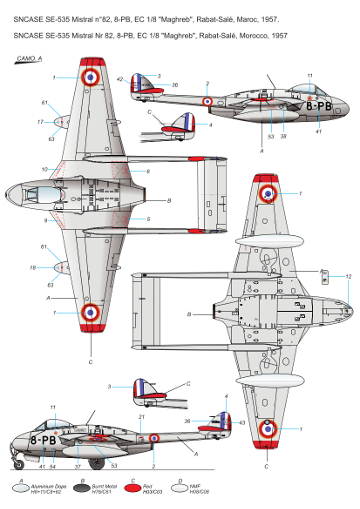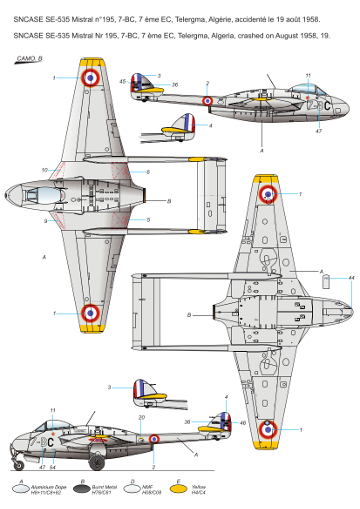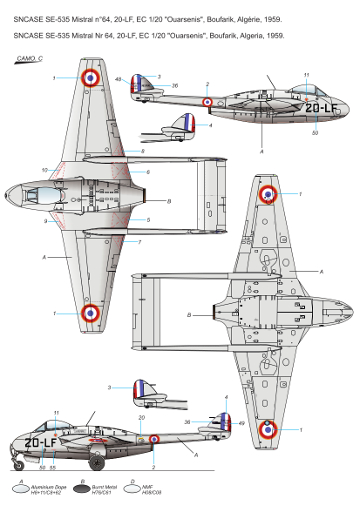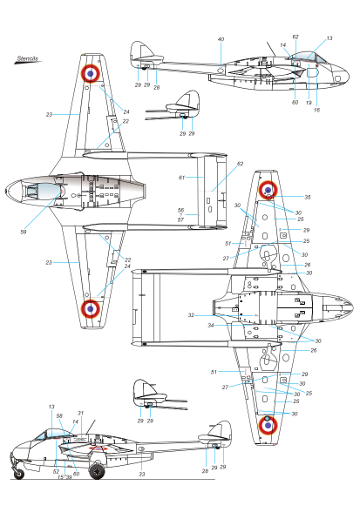FR0041 SNCASE S.E.535 Mistral
History:
The French aircraft industry, severely affected by WW2, took time to introduce indigenous designs. It initially maintained production of types on existing assembly lines like Nord’s Criquet (a modified Fieseler Storch), or launched production of licensed aircraft. Amongst the latter was the DH 100 Vampire, with 187 units built by SNCASE. The Vampire was a little under powered, so SNCASE resumed studies started by De Havilland to install the Rolls-Royce Nene engine in the Vampire.
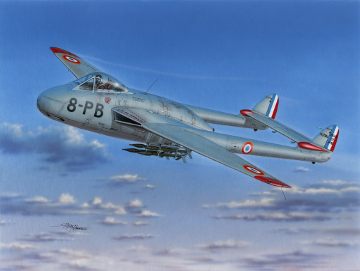
The Mistral (aka Vampire FB.53) exploited the more powerful Nene engine, also built under license in France. It delivered 61% more thrust than the DH Goblin 2 used to power the majority of single-seat Vampires, yet was only slightly bigger. This imposed important modifications of the aircraft: The air inlets were redesigned, and exploited Armstrong Whitworth’s work on developing wing root air-intakes for their Nene-powered Sea Hawk. This meant the Mistral did not have to resort to the use of additional external air-intakes protruding as paired scoops from the fuselage to meet the Nene’s airflow needs (unlike British and Australian Nene-powered Vampires). The wings were modified to carry drop-tanks, and the fuselage belly was slightly inflated to facilitate engine air flow.
The first 97 Mistrals produced were designated SE-532 and had fixed seats. The following production aircraft were equipped with ejection seats and designated SE-535. Additional ejection seats were produced and retrofitted to SE-532s during maintenance periods, after which they were re-designated as SE-535s.
Probably the best performing and most refined single seat Vampire variant, the Mistral was not much faster despite its extra power due to the airframe’s critical Mach limitations, which could easily be exceeded at higher altitudes. Despite this, on December 21, 1952, Jacqueline Auriol broke the female world speed record on a Mistral, which was later assigned to the 7th EC.
SNCASE built 247 Mistrals between 1951 and 1953 at its Marignane plant. Airframe N°2 was tested ski landing gear. Air conditioning was added to aircraft serving in North Africa, and, following numerous canopy breaks, the maximum altitude was limited to 7,500 m.
The following Escadres de Chasse were equipped with Mistrals: 6th (Oran-La Sénia), June 1952/1960, 7th (Bizerte-Sidi Ahmed), Spring 1953/1961, 5th (Orange-Caritat) 1954/1957, 8th (Rabat-Salé), March 1955 / September 1959. They were all engaged in Algeria, as well as the Escadron 1/20 (based in Oran then Boufarik) which used the Mistrals from the 7th EC from December 1957 until October 1960. Mistrals were also assigned to Training.
Specifications: single-seat single-engined fighter and ground attack plane. Engine: Rolls-Royce NENE of 2,270 kgp. Wingspan 11.58 m, length 9.37 m, wing area 24.25 m2, mass 4,926 kg. Maximum speed: 915 km/h. Ceiling 13,400 m range 1,300 km, 1,800 km with additional tanks. Armament: 4 Hispano M50 20mm cannon. Capacity for eight rockets, two 450 kg bombs, or two drop-tanks of 454 litres each.
Nota Bene :
- The only external difference between SE-532 and SE-535, nicknamed "Mistral" in Armée de l'Air, stays in the pilot seat. SE-535 got an ejectable seat SNCASO E 86, also retroactively fitted on SE-532 during maintenance operations - so the SE-532 became then SE-535 (97 SE-532 produced).
- We will provide only the seat (resin) for the SE-535. No PE in this one.
Documentation (in french) :
- Fana de l'Aviation n°129 à 131 (August to October 1980), Jean Jacques Petit, Editions Larivière
Camouflages :
- Mistral SE-535 n°82, 8-PB, EC 1/8 "Maghreb", Rabat-Salé, Morocco, 1957.
- Mistral SE-535 n°195, 7-BC, 7 ème EC, Telergma, Algeria, 19 th of August, 1958.
- Mistral SE-535 n°64, 20-LF, EC 1/20 "Ouarsenis", Boufarik, Algeria, 1959.
